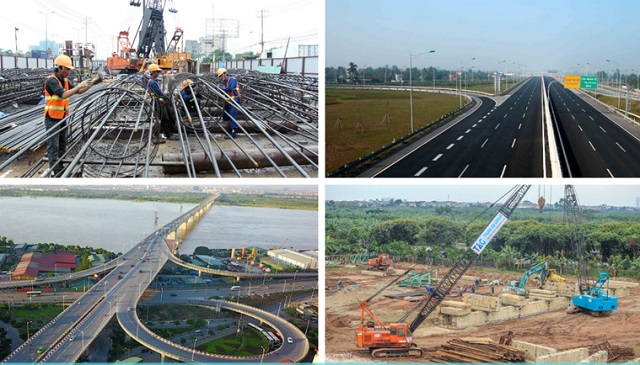
|
On numerous occasions, the Prime Minister has been present at construction sites since the early morning or late at night, working through holidays to address difficulties and obstacles on-site, demanding the decisive disbursement of public investment capital according to plans.
|
Fully aware of its importance, Prime Minister Pham Minh Chinh has been directly directing, urging, and inspecting numerous key public investment projects nationwide since the beginning of his term. On numerous occasions, the Prime Minister has been present at construction sites since the early morning or late at night, working through holidays to address difficulties and obstacles on-site, demanding the decisive disbursement of public investment capital according to plans. The political determination is clear – but to realize the development goals, the Prime Minister and the Government need an accompanying mechanism: a Public Investment Law that is flexible, transparent, and effective.
Currently, the Government has submitted to the 9th session of the 15th National Assembly a law amending multiple laws in the fields of investment, finance, and budget, including the Public Investment Law.
In reality, the current Public Investment Law has established a relatively comprehensive and stringent legal framework for the formulation, appraisal, approval, and supervision of investments using state budget capital. Thanks to this Law, fiscal discipline and the efficiency of public investment capital utilization have been gradually improved, curbing scattered and fragmented investments and losses. Important principles such as publicity, transparency, accountability, and social supervision have been institutionalized, contributing to enhanced public investment governance across the system.
However, in the new context – with the demands for rapid economic recovery, promotion of digital transformation, large-scale infrastructure investment, and attraction of private resources – the limitations in flexibility, compatibility, and synchronization in the implementation of the Public Investment Law are becoming increasingly apparent. Therefore, the reform of the Public Investment Law does not aim to deny the achievements but to improve the institution and address the bottlenecks we are facing to meet practical requirements.
Major bottlenecks in the Public Investment Law
1. Cumbersome procedures, complex and dispersed investment cycle
One of the most common complaints is that the public investment process involves too many layers, lacking integration and flexibility. From the formulation of investment policies to project appraisal and approval, medium-term to annual capital allocation plans, and capital plan adjustments – each step requires consultation, submission to competent authorities, and supplementary documents according to different forms. The involvement of multiple agencies leads to overlaps, delays, and unclear responsibilities. As a consequence, investment opportunities are missed, project commencement is delayed, and capital utilization efficiency is significantly reduced.
2. Prolonged low disbursement rate: having money but unable to spend it
The situation of “money lying idle in the State Treasury” is no longer an isolated phenomenon but has become a chronic problem, recurring for many consecutive years. The consequence is that many infrastructure projects are delayed, capital costs increase, growth opportunities are missed, and, more importantly – trust in the state’s policies is eroded.
3. Inflexible capital adjustment mechanism
When a project encounters difficulties in disbursement – due to site clearance, design documentation, or bidding procedures – transferring capital to another project is not easy as the Law stipulates it too strictly. This creates a “full-line blockage” effect: a small bottleneck can stall the entire public investment plan of a sector, locality, or even a fiscal year.
4. Inflexible provisions on public capital in PPP projects
Although the 2020 Law on Public-Private Partnership (PPP) has established a separate legal framework for public-private partnership projects, when using state capital to support the construction of works, this portion of capital must still follow the procedures of the Public Investment Law. According to Clause 5, Article 70 of the PPP Law, state capital is managed as a separate sub-project or item and is fully subject to public investment law.
Applying both the PPP Law and the Public Investment Law makes the project implementation procedures complicated, prolonged, and inflexible – contrary to the characteristics of the PPP model. This increases legal risks, creates a sense of wariness among the private sector, and affects the ability to mobilize non-state budget resources. To address this, it is necessary to review and adjust the coordination mechanism between the two Laws towards clarity, simplicity, and practicality.
5. “Fear of making mistakes” paralyzes the implementing apparatus
The Law stipulates fairly severe legal responsibilities but lacks clarity on evaluation criteria or principles for handling mistakes. This leads to a sense of concern and fear of being held accountable for violations, even for technical or procedural errors. In the context of incomplete laws and inconsistent guidance, many officials choose “not to do rather than to do wrong.” Personal safety overrides the motivation to act for work efficiency.

|
Public investment is a development driver
|
Deep-rooted causes of institutional bottlenecks
The bottlenecks in the implementation of the Public Investment Law are not only the result of a lack of synchronization in the guiding documents or the capacity of local officials but also stem from fundamental problems in legislative thinking, institutional design, and the approach to risk management in the public sector.
1. Legislative thinking inclined towards control rather than creation
The Public Investment Law was formulated in a context of tightening discipline and preventing losses, so the dominant thinking was to control input instead of promoting output. Each procedure and step was designed as a layer of protection against violations, but it inadvertently became a barrier that made the entire system operate slowly. As a result, instead of creating a mechanism that encourages innovation and a daring spirit, the Law encourages a sense of safety and avoidance.
2. Lack of project classification according to risk levels
Although the Public Investment Law has classified projects into groups A, B, and C with corresponding procedures, in reality, this distinction mainly concerns investment decision-making authority, appraisal time, and approval procedures, without leading to a significantly different administrative procedure system, supervision mechanism, or governance model. Many procedures are still applied relatively uniformly, causing some small-scale, low-risk projects to go through a cumbersome process, wasting time and resources. This indicates that the Law still lacks a sophisticated risk management mechanism, which is the core of the modern public investment management model in many developed countries.
3. Half-hearted decentralization, delegation of tasks without corresponding authority
Although the Law mentions the principle of decentralization, in reality, decision-making authority remains concentrated in the Central government, especially in capital plan adjustments, changes in investment policies, or project list approvals. Localities are only implementing units but are bound by a bureaucratic process. Delegating tasks without corresponding authority and adjustment tools makes it difficult for local officials to proactively address practical difficulties, leading to passivity and dependence.
4. Supervision mechanism mainly based on pre-checks, lacking effective post-checks
Currently, public investment control is mainly focused on the pre-implementation phase – approval, appraisal, and acceptance – while the post-implementation phase, such as implementation, acceptance, and evaluation of effectiveness, lacks a strong and independent supervision mechanism. The supervision system relies on people and paper documents, lacking the application of technology and digital data. This not only fails to prevent violations in practice but also creates excessive pressure in the initial phase, slowing down the entire investment implementation process.
From the above root causes, it can be seen that amending the Public Investment Law is not just a technical adjustment but requires a comprehensive reform in thinking – shifting from old-style legalism to modern governance, with effectiveness and results as the center.

|
A fundamental institutional reform in public investment is needed
|
Radical reform solutions according to international standards
For public investment to truly become a growth driver rather than a development hindrance, Vietnam needs a fundamental institutional reform, not just technical fixes. This reform should be based on four core principles of modern public governance: empowerment – accountability – intelligent supervision – focus on output results. Specifically:
1. Redesign the investment process towards flexibility and integration
First, it is necessary to streamline and integrate the fragmented procedures. The steps of formulating investment policies, appraising and approving projects, and allocating capital should be consolidated into a seamless process, instead of being divided into multiple layers as they are today.
Especially, the “rolling plan” model – a common international practice – should be applied instead of making fixed five-year and annual plans. (This is an investment plan that is periodically reviewed, updated, and adjusted based on the approved medium-term plan, instead of being made once and then “framed” for five years.) Thanks to this, projects can be flexibly updated when conditions are ripe, avoiding the time spent waiting for the new planning phase.
2. Classify projects according to risk levels and scale to adjust procedures appropriately
We need to move away from the thinking of “one size fits all” – instead, build a system of procedures based on risk and investment scale classification. Small-scale, low-risk projects (e.g., commune-level infrastructure upgrades, intra-city infrastructure…) should follow a simplified process, with more power delegated to localities. Large-scale, high-risk projects require a stricter process, with independent appraisals and public information disclosure for social supervision.
This approach not only saves time and resources but also focuses control on high-risk areas – in line with the principle of “governance based on risk” widely applied by OECD countries.
3. Substantive decentralization and empowerment with corresponding accountability mechanisms
There must be a shift from “formal decentralization” to “substantive empowerment.” Localities and sectors should be empowered to adjust capital plans within their assigned scope, instead of having to seek Central approval for every minor change.
Along with this, it is necessary to apply the model of “responsibility contract” between the Central and local governments – in which empowerment is accompanied by personalized accountability. Those who fail to achieve disbursement targets should be evaluated and handled based on output results, instead of blaming the process.
4. Reasonably adjust the application of the Public Investment Law in PPP projects
Currently, the portion of state capital in PPP projects must still comply with the procedures of the Public Investment Law, leading to cumbersome, prolonged procedures and reducing flexibility – which is the core strength of the PPP model. Therefore, it is necessary to limit the scope of application of the Public Investment Law only to the portion of public capital, not extending it to the entire project, while simplifying administrative procedures and ensuring harmony between the two Laws through inter-connected guidance or appropriate amendments. This solution will help unlock private resources, promote infrastructure investment, and improve the effectiveness of public-private cooperation.
5. Strongly shift from pre-checks to post-checks, with independent and transparent supervision
Investment efficiency does not lie in the approval of documents but in the final results on the ground. It is necessary to build an independent post-completion evaluation system – assessing the actual effectiveness of projects and publicly disclosing the results to create social pressure.
Instead of piling up approval procedures, let localities take the initiative in implementation and be responsible for the results, similar to the models applied in New Zealand and Canada.
6. Comprehensive digitalization of the public investment cycle, with transparency and real-time updates
Finally – and fundamentally – it is essential to digitize the entire public investment ecosystem. An integrated data system should be established at the national level, connecting the State Treasury, the Ministry of Finance, localities, and investors.
Information on progress, disbursement, obstacles, and output results should be updated in real-time and made transparent on a digital platform. This will not only serve as an intelligent supervision tool but also help address the fear of responsibility, as everything is transparent.
A revolutionary reform in public investment is needed
Amending the Public Investment Law is not just a technical adjustment but a revolutionary institutional reform – a shift from a controlling mindset to a creative one.
To achieve this, the Public Investment Law needs to be redesigned according to modern governance principles: empowerment – accountability – intelligent supervision – focus on output results. Only then can public investment truly become a development driver, instead of the bottlenecks that exist today.
Dr. Nguyen Si Dung
The Bidding Law and the Urgent Need for Amendments
As of May 17, 2025, during a group discussion at the National Assembly on the draft Law amending and supplementing a number of articles of the Bidding Law and related laws on public investment, General Secretary To Lam pointed out four critical issues in the current Bidding Law: delaying the country’s development, lowering the quality of projects, wasting resources, and corrupting and losing personnel.
The Giant Golden Turtle Back Exhibition Center: On Track to Break Global Records with an Unprecedented 10.5-Month Construction Sprint
The Vietnam National Exposition Center, a world-class exhibition center, is set to break records and become a new landmark in the capital city. With an ambitious timeline of just 10 months for the main exhibition hall and a total project completion time of 10.5 months, this project is a testament to the exceptional capabilities and reputation of Vingroup. This state-of-the-art facility, ranking among the top 10 globally, will not only be a magnificent addition to the city but will also revolutionize the construction industry, marking a significant milestone as the nation celebrates its 80th anniversary of independence.
“Unleashing the Power of Public Investment: The Prime Minister’s Initiative for Growth”
On the morning of May 20, Prime Minister Pham Minh Chinh chaired a conference on promoting investment growth momentum in 2025, with the ambitious target of achieving a 100% disbursement rate of public investment funds for the year (up from the previous target of 95%).
“PM Calls for Review of Officials in Areas with Slow Public Investment Disbursement”
Recapping the results of public investment in the first months, with 37 out of 47 ministries and agencies and 27 out of 63 localities having a disbursement rate below the national average, the Prime Minister requested to clarify this issue, identify the causes, and point out the difficulties, obstacles, bottlenecks, and responsibilities of the ministries and sectors. He asked, “Why, with the same conditions and policies, do some places perform well while others do not? Is it due to the people or the leaders?”





















